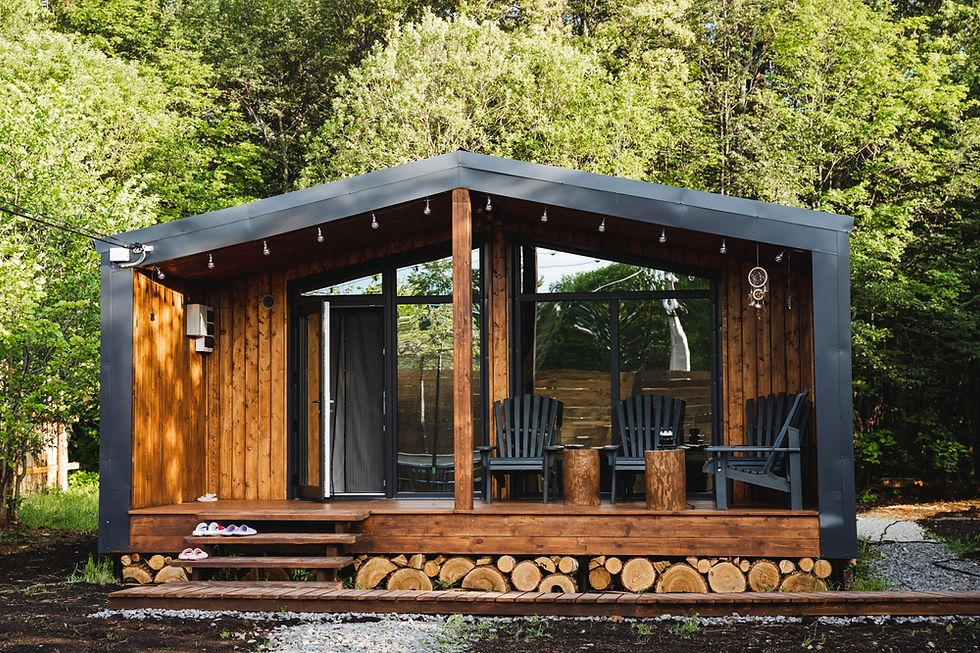Maximize Your Area With Modern Retreat Sheds
- Ashley Kinsela
- Sep 2, 2025
- 6 min read
Updated: Sep 4, 2025

Have you ever contemplated the possibility of putting that space at the back of your house to some use? Perhaps you dream secretly of a little getaway from all the noise and activities in the main house-a personal little sanctuary to escape to whenever you need a little bit of "me time." Perhaps a modern retreat shed has crossed your mind as a solution?
Modern retreat sheds create ripples in the way Australians think about their backyards and other outdoor spaces. Retreat sheds have evolved from mere garden storages into sophisticated multipurpose spaces capable of transforming one's property. These versatile structures can evolve into home offices or creative studios, be easily converted into guest accommodations, and be enjoyed as entertainment areas, and so much more; these multifunctional retreats provide endless possibilities for maximizing your available space while adding considerable value to your property.
In this detailed guide, we cover everything you need to know about the modern retreat sheds in Australia. You will learn about the essential planning considerations, get inspired by the striking design ideas for the Australian conditions, and discover how to avoid the common traps. We will discuss costs, council requirements, and creative uses of your new space. Whether a backyard workshop, a granny flat, or a peaceful retreat for relaxation, with this reading, you will be equipped with his lessons and inspiration to make this vision a reality.
What Is A Retreat Shed?
Lifestyle Spaces: From Basic Storage To
Garden sheds have come a long way from storing lawn-mowing equipment and gardening tools. Retreat sheds have transformed the concept that it is an entirely different function. These can even go as far as being completely livable spaces extensions to the home offer comfort, style, and purpose.
The change in lifestyles and need for flexibility space will require people to consider living more casually. With increasing property prices and the rise of remote workplaces, Australians find ways to extend their spaces with minimal costs and excessive hassles of constructing extensions to the home. Those people who are seeking affordable versatile additional spaces to adapt with time can completely find what they need in these modern retreats.
The advances in construction materials and insulation technology along with the innovations in designs determine the big difference making traditional storage units today into lifestyle spaces. Retreat sheds now could have double-glazed windows, climate control systems, full bathrooms, and kitchenettes, thus, making them a true alternative to expand a house physically.
Key Differences Between Traditional Sheds And Modern Retreat Designs
Just a very few of the traditional sheds are more on usage than for comfort, as it is very basic in construction with the least insulation and source of natural light, which mainly focuses on storage or small workshop activities. Comfort, aesthetics, and versatility become the priorities of modern retreats.
One of the best distinctions is on how these are built. A retreat shed would normally be expected to have a good foundation, insulation, weather-proofing, and often-even from the outset-electrical wiring and plumbing. The windows are larger and better located to capture sunlight, while the doors are almost always sliding glass panels, thereby creating a free flow between the inside and outside.
Once again, fittings inside retreat sheds compete with modern homes. There are plasterboard walls, waiting for painting, quality flooring options-from polished concrete to timber-and built-in storage solutions. Spaces become comfortable year-round because they are meant to have proper ventilation systems and provisions for heating and cooling.
Planning Your Perfect Retreat Shed: Essential Things To Consider
Check Your Space With The Possible Restrictions Of Your Council
Before there can be any design consideration or floor planning, it has to be established what is actually possible on your property. First, measure the space you have. Then measure what is already there: the big buildings, the trees, and even the utility lines. Take sun exposure into account throughout the day, and consider how position will affect both privacy and views from your main house.
Most councils in Australia regulate secondary structures, which often include maximum size allowances, some setback requirements from boundaries, and height restrictions generally observed. Structures under 10 square metres do not require approval in many places, but retreat sheds are usually above this area; it is worth finding out early with your local council.
Consider such factors as whether construction vehicles and materials can get into the area during the build. Think about how you will connect utilities-the nearer it is to original power and water connections, the more budget-friendly it will be for installation.
Quality Retreat Sheds In Australia: How Much Would They Cost?
Budget consideration is important when designing your actual retreat shed. From about 5,000 to 10,000 dollars, a basic kit shed may qualify for conversion, but a real retreat space will generally need some extra investments. Quality retreat sheds that are made for the purpose, with insulation, windows, and a simple fit-out, are generally priced in the range of 15,000 to 40,000 dollars.
However, to create a nice place with bathrooms, kitchenette, and high-end finishes, costs can go up to 50,000 dollars or more. Compared with a traditional home extension, usually going above 100,000, it indeed sounds like a great deal. Since many designs are modular, you can start with the basic shell and progressively add on as your budget allows.
Make sure to include the site preparation, council fees, utility connections, and furnishing costs for the interior decoration. Run multiple quotes and be sure that you completely understand what is included in the total to avoid unpleasant surprises with your budget later on.
Do You Need Council Approval For A Retreat Shed?
In most cases, a retreat shed will require some sort of approval from the local council. The requirements vary greatly between councils, and may depend on the size, use, and zoning of the shed on your property. Habitable structures usually come under more stringent conditions as opposed to those structures indicated for storage or hobby use.
Based on the type of approval, the situation could be a very simple Complying Development Certificate (CDC), or full Development Application (DA). CDC is faster and cheaper, but with rigid guidelines. DA, on the other hand, takes longer, but it also enables more freedom and flexibility with unique designs or challenging sites. Some councils will provide fast-track approval for standard designs of sheds that meet the criteria.
An easy way is to work with a shed supplier who knows the local regulations. Many reputable companies may take care of the application on your behalf, providing you peace of mind, time, and avoid many potential headaches.
Making The Best Of Your Investment

How Retreat Sheds Can Add Value To Your Property
Good retreat sheds can really raise the value of your property, as well as their appeal to buyers. According to real estate agents, properties with a retreat shed that is well-designed usually sell faster and at higher prices. These structures appeal to many buyers: those needing home office space, to families requiring teenage retreat space.
Key to maximizing value is quality build and multiple use design. Sheds that have transient uses are the most appealing. A space currently occupied as an art studio, for example, could be transformed into a new owner's home office, while guest accommodation may convert into a teenage retreat.
Presentation is the key to selling. Stage your retreat shed to give it maximum potential, with all council approvals and compliance certificates to hand. Grasp the running cost, especially where energy-efficient features were included.
Maintenance Tips For Gradually Extending The Shed Professional Appearance
Annual maintenance keeps your shed resort functional as well as new always. Check for wear, water damage, and pests every year. Do little repairs immediately before they become big expenses.
External Maintenance usually varies in their procedures and coverage depending on different materials, cleaning gutters, viewing seals around the doors and windows, as well as repainting or resealing when needed. Timber cladding requires more attention than steel, but when cared for, it will acquire beautiful character in due season.
Internal maintenance also involves finishes and ensuring the presence of operating systems. Have an annual service done on air conditioning systems, check on smoke detectors, and service every plumbing fixture. Put together a maintenance record containing the warranties of all materials used; this will help a great deal in marketing.
Designing An Upgradeable Shed To Ensure Versatility
When designing with some flexibility in the shed-life ahead, avoid built-in features that are too specific, as they will limit future uses. Open plan layouts with as few fixed walls as possible will allow maximum adaptability.
Be all set for upgrades that might become necessary in the future if you do not require them at the moment. Such jobs usually include running extra conduit for data cables, roughing in plumbing for a future bathroom, or installing backing for wall-mounted TVs; these things do not cost much while constructing but could save a lot down the track.
Accessibility is the key feature whether you need it now or not. Wider doorways, level entries, and reinforced walls for grab rails create a useable environment for people of all abilities and ages.
Your Journey Towards Achieving The Perfect Retreat Shed Begins Here
Today, modern retreat sheds form a very exciting opportunity to explore all the potentials all that extra space can create for you. In the foregoing discussion, we've seen how these versatile structures have transformed themselves from storage units into much more sophisticated spaces transforming Australian lifestyles. From home offices and creative studios all the way to guest accommodation and entertainment spaces, virtually nothing is truly off the table.









Comments